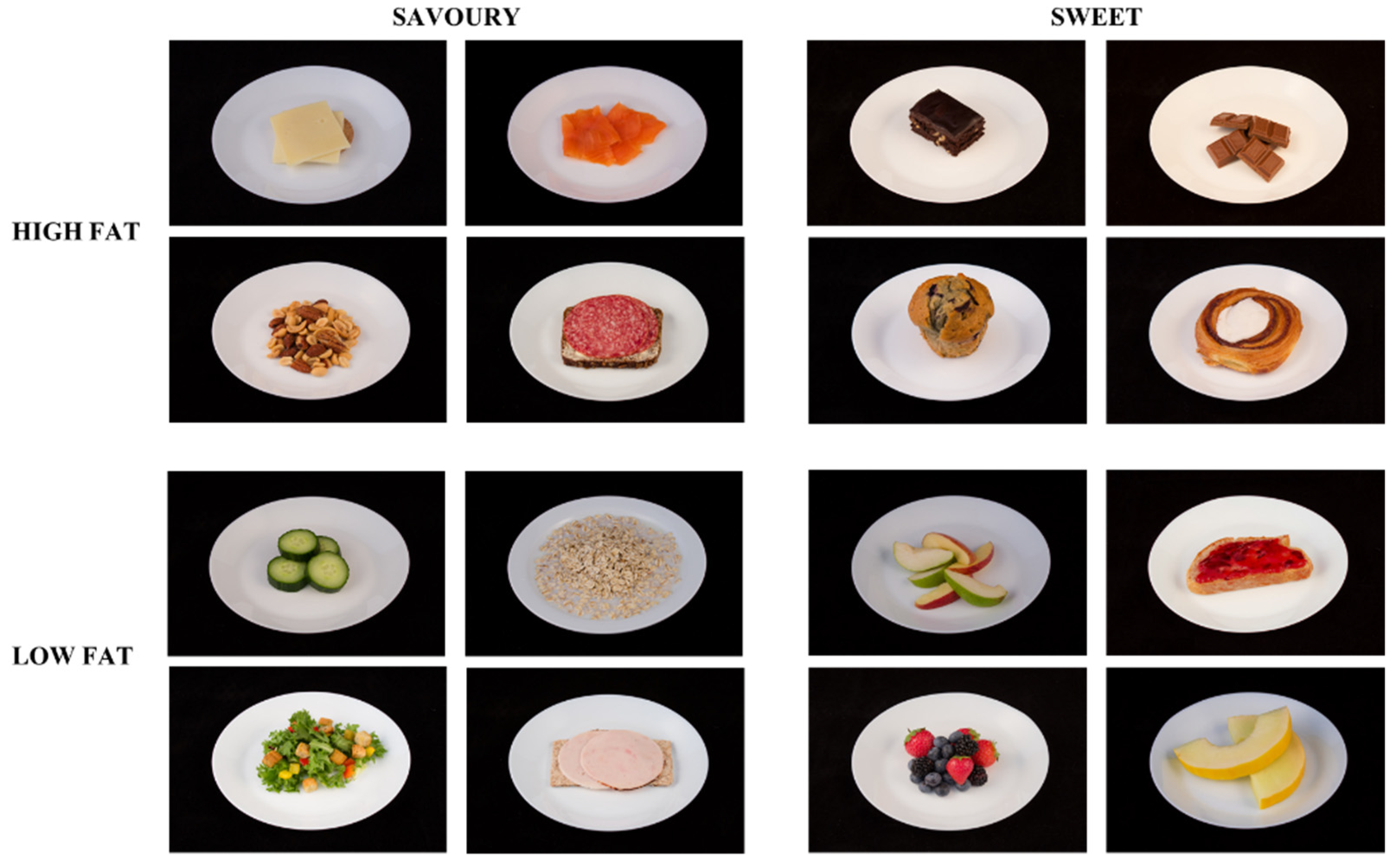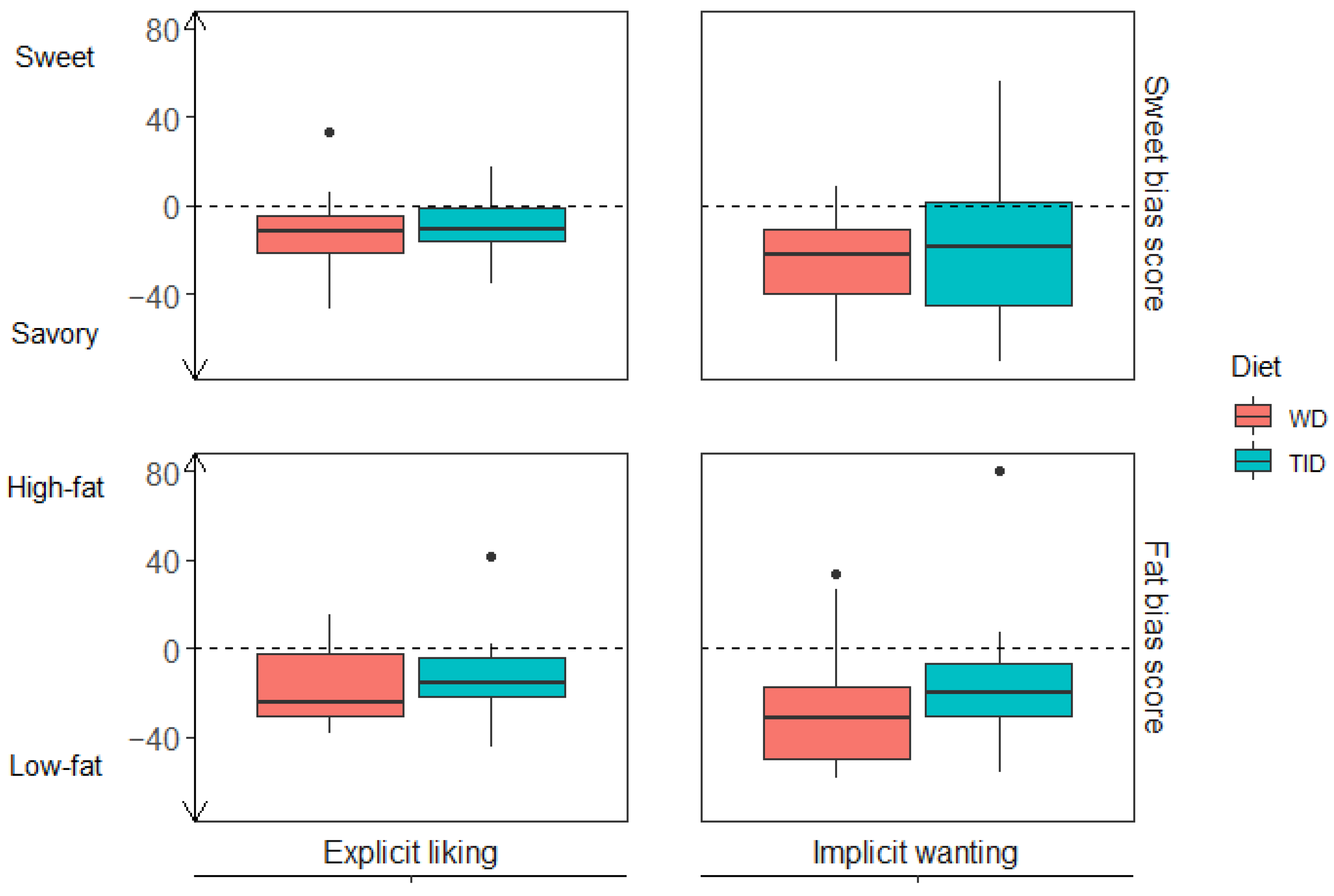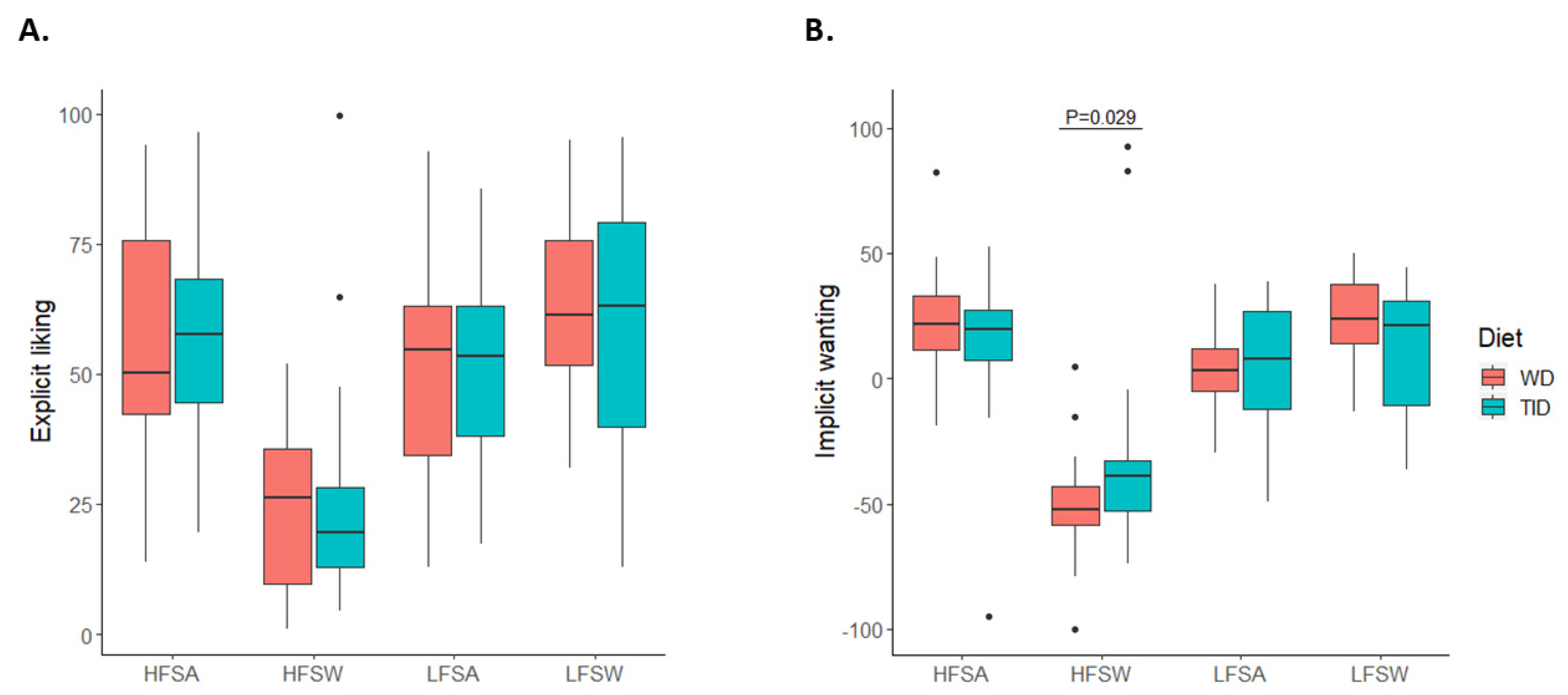Food Reward after a Traditional Inuit or a Westernised Diet in an Inuit Population in Greenland
Abstract
1. Introduction
2. Materials and Methods
2.1. Study Population and Location
2.2. Intervention for the Present Subgroup
2.3. Study Procedure and Examinations
2.3.1. Food Reward
2.3.2. Anthropometry
2.3.3. Interviews and Assessment of Food Intake
2.4. Data Analyses & Calculations
2.4.1. Food Reward
Sweet Bias and Fat Bias Scores
Combined Food Categories
2.4.2. Food Intake
2.5. Statistical Methods
3. Results
3.1. Participant Characteristics
3.2. Food Reward
3.2.1. Sweet Bias and Fat Bias Scores
3.2.2. Combined Food Categories
3.3. Food Intake
4. Discussion
5. Conclusions
Supplementary Materials
Author Contributions
Funding
Institutional Review Board Statement
Informed Consent Statement
Data Availability Statement
Acknowledgments
Conflicts of Interest
References
- Jeppesen, C.; Bjerregaard, P. Consumption of traditional food and adherence to nutrition recommendations in Greenland. Scand. J. Public Health 2012, 40, 475–481. [Google Scholar] [CrossRef] [PubMed]
- Marquardt, O.; Caulfield, R.A. Development of West Greenlandic Markets for Country Foods Since the 18th Century. Arctic 1996, 49, 107–109. [Google Scholar] [CrossRef][Green Version]
- Pars, T.; Osler, M.; Bjerregaard, P. Contemporary Use of Traditional and Imported Food among Greenlandic Inuit. Arctic 2001, 54, 22–31. [Google Scholar] [CrossRef]
- Bjerregaard, P.; Jeppesen, C. Inuit dietary patterns in modern Greenland. Int. J. Circumpolar Health 2010, 69, 13–24. [Google Scholar] [CrossRef] [PubMed]
- Deutch, B.; Pedersen, H.S.; Hansen, J.C. Increasing overweight in Greenland: Social, demographic, dietary and other life-style factors. Int. J. Circumpolar Health 2005, 64, 86–98. [Google Scholar] [CrossRef]
- Deutch, B.; Dyerberg, J.; Pedersen, H.S.; Aschlund, E.; Hansen, J.C. Traditional and modern Greenlandic food—Dietary composition, nutrients and contaminants. Sci. Total Environ. 2007, 384, 106–119. [Google Scholar] [CrossRef] [PubMed]
- Bjerregaard, P.; Mulvad, G. The best of two worlds: How the Greenland Board of Nutrition has handled conflicting evidence about diet and health. Int. J. Circumpolar Health 2012, 71, 18588. [Google Scholar] [CrossRef][Green Version]
- Larsen, C.V.L.; Hansen, C.B.; Christine, I.; Jørgensen, M.E.; Olesen, I.; Sørensen, I.K.; Kock, A.; Backer, V.; Bjerregaard, P. Befolkningsundersøgelsen i Grønland Levevilkår, Livsstil og Helbred; Statens Institut for Folkesundhed, SDU: Copenhagen, Denmark, 2019; ISBN 9788778994554. [Google Scholar]
- Johnson, F.; Wardle, J. Variety, Palatability, and Obesity. Adv. Nutr. 2014, 5, 851–859. [Google Scholar] [CrossRef]
- Morales, I.; Berridge, K.C. ‘Liking’ and ‘wanting’ in eating and food reward: Brain mechanisms and clinical implications. Physiol. Behav. 2020, 227, 113152. [Google Scholar] [CrossRef]
- Recio-Román, A.; Recio-Menéndez, M.; Román-González, M.V. Food Reward and Food Choice. An Inquiry Through The Liking and Wanting Model. Nutrients 2020, 12, 639. [Google Scholar] [CrossRef]
- Oustric, P.; Thivel, D.; Dalton, M.; Beaulieu, K.; Gibbons, C.; Hopkins, M.; Blundell, J.; Finlayson, G. Measuring food preference and reward: Application and cross-cultural adaptation of the Leeds Food Preference Questionnaire in human experimental research. Food Qual. Prefer. 2020, 80, 103824. [Google Scholar] [CrossRef]
- Clark, E.N.; Dewey, A.M.; Temple, J.L. Effects of daily snack food intake on food reinforcement depend on body mass index and energy density. Am. J. Clin. Nutr. 2009, 91, 300–308. [Google Scholar] [CrossRef] [PubMed]
- Stice, E.; Burger, K. Neural vulnerability factors for obesity. Clin. Psychol. Rev. 2019, 68, 38–53. [Google Scholar] [CrossRef] [PubMed]
- Tvermosegaard, M.; Dahl-Petersen, I.K.; Nielsen, N.O.; Bjerregaard, P.; Jørgensen, M.E. Cardiovascular Disease Susceptibility and Resistance in Circumpolar Inuit Populations. Can. J. Cardiol. 2015, 31, 1116–1123. [Google Scholar] [CrossRef] [PubMed]
- Jørgensen, M.E.; Borch-Johnsen, K.; Witte, D.R.; Bjerregaard, P. Diabetes in Greenland and its relationship with urbanization. Diabet. Med. 2011, 29, 755–760. [Google Scholar] [CrossRef] [PubMed]
- Møller, G.; Lind, M.V.; Hauptmann, A.L.; Senftleber, N.; Hansen, C.B.; Hansen, T.; Jørgensen, M.E.; Lauritzen, L. The role of a traditional and western diet on glucose homeostasis in Greenlandic Inuit carriers and non-carriers of type 2 diabetes variant in the TBC1D4 gene: A protocol for a randomized clinical trial. Contemp. Clin. Trials Commun. 2021, 21, 100734. [Google Scholar] [CrossRef]
- Pedersen, H.; Quist, J.S.; Jensen, M.M.; Clemmensen, K.K.B.; Vistisen, D.; Jørgensen, M.E.; Færch, K.; Finlayson, G. Investigation of eye tracking, electrodermal activity and facial expressions as biometric signatures of food reward and intake in normal weight adults. Food Qual. Prefer. 2021, 93, 104248. [Google Scholar] [CrossRef]
- Jeppesen, C.; Jørgensen, M.E.; Bjerregaard, P. Assessment of consumption of marine food in Greenland by a food frequency questionnaire and biomarkers. Int. J. Circumpolar Health 2012, 71, 18361. [Google Scholar] [CrossRef]
- Horner, K.M.; Finlayson, G.; Byrne, N.M.; King, N.A. Food reward in active compared to inactive men: Roles for gastric emptying and body fat. Physiol. Behav. 2016, 160, 43–49. [Google Scholar] [CrossRef]
- Dalton, M.; Blundell, J.; Finlayson, G.S. Examination of food reward and energy intake under laboratory and free-living conditions in a trait binge eating subtype of obesity. Front. Psychol. 2013, 4, 757. [Google Scholar] [CrossRef]
- Blundell, J.; Finlayson, G.; Axelsen, M.; Flint, A.; Gibbons, C.; Kvist, T.; Hjerpsted, J.B. Effects of once-weekly semaglutide on appetite, energy intake, control of eating, food preference and body weight in subjects with obesity. Diabetes Obes. Metab. 2017, 19, 1242–1251. [Google Scholar] [CrossRef] [PubMed]
- Oustric, P.; Beaulieu, K.; Casanova, N.; O’Connor, D.; Gibbons, C.; Hopkins, M.; Blundell, J.; Finlayson, G. Food Liking but Not Wanting Decreases after Controlled Intermittent or Continuous Energy Restriction to ≥5% Weight Loss in Women with Overweight/Obesity. Nutrients 2021, 13, 182. [Google Scholar] [CrossRef] [PubMed]
- Zhou, Y.; Finlayson, G.; Liu, X.; Zhou, Q.; Liu, T.; Zhou, C. Effects of Acute Dance and Aerobic Exercise on Drug Craving and Food Reward in Women with Methamphetamine Dependence. Med. Sci. Sports Exerc. 2021, 53, 2245–2253. [Google Scholar] [CrossRef] [PubMed]
- Finlayson, G.; Caudwell, P.; Gibbons, C.; Hopkins, M.; King, N.; Blundell, J.E. Low Fat Loss Response after Medium-Term Supervised Exercise in Obese Is Associated with Exercise-Induced Increase in Food Reward. J. Obes. 2010, 2011, 615624. [Google Scholar] [CrossRef] [PubMed]
- Rogers, P.J.; Hardman, C.A. Food reward. What it is and how to measure it. Appetite 2015, 90, 1–15. [Google Scholar] [CrossRef] [PubMed]
- Higgs, S. Cognitive processing of food rewards. Appetite 2016, 104, 10–17. [Google Scholar] [CrossRef]
- Finlayson, G.; Dalton, M. Hedonics of Food Consumption: Are Food ‘Liking’ and ‘Wanting’ Viable Targets for Appetite Control in the Obese? Curr. Obes. Rep. 2012, 1, 42–49. [Google Scholar] [CrossRef]
- Stice, E.; Spoor, S.; Ng, J.; Zald, D.H. Relation of obesity to consummatory and anticipatory food reward. Physiol. Behav. 2009, 97, 551–560. [Google Scholar] [CrossRef]
- Salbe, A.D.; DelParigi, A.; Pratley, R.E.; Drewnowski, A.; Tataranni, P.A. Taste preferences and body weight changes in an obesity-prone population. Am. J. Clin. Nutr. 2004, 79, 372–378. [Google Scholar] [CrossRef]
- Hansen, J.C.; Deutch, B.; Odland, J. Øyvind Dietary transition and contaminants in the Arctic: Emphasis on Greenland. Int. J. Circumpolar Health 2008, 67, 1–98. [Google Scholar] [CrossRef]
- Griffioen-Roose, S.; Finlayson, G.; Mars, M.; Blundell, J.E.; de Graaf, C. Measuring food reward and the transfer effect of sensory specific satiety. Appetite 2010, 55, 648–655. [Google Scholar] [CrossRef] [PubMed]
- Watson, Z.A.; Shanks, C.B.; Miles, M.P.; Rink, E. The Grocery Store Food Environment in Northern Greenland and Its Implications for the Health of Reproductive Age Women. J. Community Health 2017, 43, 175–185. [Google Scholar] [CrossRef] [PubMed]
- Popkin, B.M. Global nutrition dynamics: The world is shifting rapidly toward a diet linked with noncommunicable diseases. Am. J. Clin. Nutr. 2006, 84, 289–298. [Google Scholar] [CrossRef] [PubMed]
- Hall, K.D.; Ayuketah, A.; Brychta, R.; Cai, H.; Cassimatis, T.; Chen, K.; Chung, S.T.; Costa, E.; Courville, A.; Darcey, V.; et al. Ultra-Processed Diets Cause Excess Calorie Intake and Weight Gain: An Inpatient Randomized Controlled Trial of Ad Libitum Food Intake. Cell Metab. 2019, 30, 67–77.e3. [Google Scholar] [CrossRef] [PubMed]
- Young, T.K.; Bjerregaard, P.; Dewailly, É.; Risica, P.M.; Jørgensen, M.E.; Ebbesson, S.E.O. Prevalence of Obesity and Its Metabolic Correlates Among the Circumpolar Inuit in 3 Countries. Am. J. Public Health 2007, 97, 691–695. [Google Scholar] [CrossRef]
- Alsbirk, P.H. Eye health service in Greenland. Acta Ophthalmol. Scand. 2002, 80, 39–43. [Google Scholar] [CrossRef]
- Cade, J.; Thompson, R.; Burley, V.; Warm, D. Development, validation and utilisation of food-frequency questionnaires—A review. Public Health Nutr. 2002, 5, 567–587. [Google Scholar] [CrossRef]
- Hopping, B.N.; Erber, E.; Mead-Morse, E.; Sheehy, T.; Roache, C.; Sharma, S. Socioeconomic indicators and frequency of traditional food, junk food, and fruit and vegetable consumption amongst Inuit adults in the Canadian Arctic. J. Hum. Nutr. Diet. 2010, 23, 51–58. [Google Scholar] [CrossRef]




| Traditional Diet | Westernised Diet | |||
|---|---|---|---|---|
| Visit 1 | Visit 2 | Visit 1 | Visit 2 | |
| n | 20 | 20 | 24 | 24 |
| Genotype = Homozygous carriers | 3 (15.0) | 1 (4.5) | ||
| Place of residence (Qaanaaq/Qasigiannguit) | 10/10 | 7/17 | ||
| Sex = Male | 10 (50.0) | 11 (45.8) | ||
| Age, years | 60.5 (11.7) | 55.4 (9.5) | ||
| Weight, kg | 67.7 (17.3) | 66.6 (16.8) | 76.1 (15.6) | 76.1 (15.5) |
| BMI, kg/m2 | 26.0 (5.9) | 25.6 (5.7) | 27.9 (5.0) | 27.9 (4.7) |
| Fat, % | 28.3 (10.1) | 27.8 (9.8) | 32.1 (10.4) | 31.9 (10.0) |
| Fat-free mass, kg | 47.7 (11.1) | 47.3 (10.8) | 51.2 (11.0) | 51.4 (10.9) |
| Alcohol frequency | ||||
| More than 2 times per week | 3 (15.0) | 1 (10.0) | 1 (4.2) | 1 (5.3) |
| 2 times per month or less | 17 (85.0) | 9 (90.0) | 23 (95.8) | 18 (94.7) |
| Weekly alcohol intake | ||||
| 0 units | 5 (25.0) | 6 (30.0) | 8 (33.3) | 10 (41.7) |
| 1–7 units | 3 (15.0) | 2 (10.0) | 5 (20.8) | 0 (0.0) |
| 8–14 units | 3 (15.0) | 2 (10.0) | 3 (12.5) | 4 (16.7) |
| 15 or more units | 2 (10.0) | 1 (5.0) | 0 (0.0) | 0 (0.0) |
| Missing | 7 (35.0) | 9 (45.0) | 8 (33.3) | 10 (41.7) |
| Smoking status | ||||
| Current smoker | 12 (60.0) | 14 (58.3) | ||
| Previous smoker | 8 (40.0) | 6 (25.0) | ||
| Never smoked | 0 (0.0) | 4 (16.7) | ||
| Educational level | ||||
| 8th grade or less | 8 (40.0) | 8 (33.3) | ||
| 9th to 12th grade | 12 (60.0) | 16 (66.7) | ||
| Employment | ||||
| Full-time paid | 10 (50.0) | 16 (66.7) | ||
| Part-time paid | 1 (5.0) | 2 (8.3) | ||
| Self-employed (fishing/fisheries) | 0 (0.0) | 1 (4.2) | ||
| Pensioner | 7 (35.0) | 3 (12.5) | ||
| Other | 2 (10.0) | 2 (8.3) | ||
| Traditional Inuit Diet | Westernised Diet | |||
|---|---|---|---|---|
| Baseline | During Intervention | Baseline | During Intervention | |
| n | 20 | 20 | 24 | 24 |
| Traditional foods | ||||
| Berries | 3.0 (0.2, 12.9) | 0.0 (0.0, 9.9) | 3.0 (0.7, 4.3) | 0.7 (0.0, 3.0) |
| Marine mammals | 35 (9, 72) | 102 (26, 257) | 11 (8, 46) | 4 (0, 10) |
| Fish | 61 (15, 86) | 98 (67, 147) | 49 (24, 63) | 7 (4, 13) |
| Meat (traditional) | 15 (5, 29) | 29 (15, 63) | 14 (7, 23) | 1 (0, 5) |
| Imported foods | ||||
| Meat (imported) | 194 (97, 253) | 70 (31, 152) | 143 (74, 193) | 164 (110, 248) |
| Fruit/Fruit juice | 117 (35, 176) | 40 (13, 200) | 99 (37, 146) | 80 (51, 153) |
| Vegetables | 202 (132, 277) | 83 (37, 264) | 192 (142, 257) | 176 (135, 241) |
| Dairy products | 153 (40, 242) | 83 (18, 171) | 74 (35, 178) | 140 (57, 181) |
| Cereal products | 236 (165, 330) | 198 (53, 260) | 236 (186, 315) | 234 (193, 290) |
| Ultra-processed, imported foods | ||||
| Cake | 4 (2, 16) | 4 (2, 7) | 7 (2, 16) | 8 (7, 19) |
| Candy | 7 (2, 22) | 2 (1, 12) | 6 (2, 9) | 7 (3, 17) |
| Sugar-sweetened beverages | 201 (44, 330) | 45 (16, 302) | 254 (151, 420) | 232 (160, 421) |
| Sugar in coffee/tea | 2.0 (0.0, 10.0) | 0.5 (0.0, 5.5) | 3.5 (0.0, 10.5) | 2.0 (0.0, 10.5) |
| Ultra-processed high-fat foods | 20 (4, 31) | 12 (1, 24) | 17 (7, 23) | 23 (9, 32) |
Publisher’s Note: MDPI stays neutral with regard to jurisdictional claims in published maps and institutional affiliations. |
© 2022 by the authors. Licensee MDPI, Basel, Switzerland. This article is an open access article distributed under the terms and conditions of the Creative Commons Attribution (CC BY) license (https://creativecommons.org/licenses/by/4.0/).
Share and Cite
Pedersen, H.; Beaulieu, K.; Finlayson, G.; Færch, K.; Jørgensen, M.E.; Lewis, J.I.; Lind, M.V.; Lauritzen, L.; Quist, J.S. Food Reward after a Traditional Inuit or a Westernised Diet in an Inuit Population in Greenland. Nutrients 2022, 14, 561. https://doi.org/10.3390/nu14030561
Pedersen H, Beaulieu K, Finlayson G, Færch K, Jørgensen ME, Lewis JI, Lind MV, Lauritzen L, Quist JS. Food Reward after a Traditional Inuit or a Westernised Diet in an Inuit Population in Greenland. Nutrients. 2022; 14(3):561. https://doi.org/10.3390/nu14030561
Chicago/Turabian StylePedersen, Hanne, Kristine Beaulieu, Graham Finlayson, Kristine Færch, Marit Eika Jørgensen, Jack Ivor Lewis, Mads Vendelbo Lind, Lotte Lauritzen, and Jonas Salling Quist. 2022. "Food Reward after a Traditional Inuit or a Westernised Diet in an Inuit Population in Greenland" Nutrients 14, no. 3: 561. https://doi.org/10.3390/nu14030561
APA StylePedersen, H., Beaulieu, K., Finlayson, G., Færch, K., Jørgensen, M. E., Lewis, J. I., Lind, M. V., Lauritzen, L., & Quist, J. S. (2022). Food Reward after a Traditional Inuit or a Westernised Diet in an Inuit Population in Greenland. Nutrients, 14(3), 561. https://doi.org/10.3390/nu14030561







